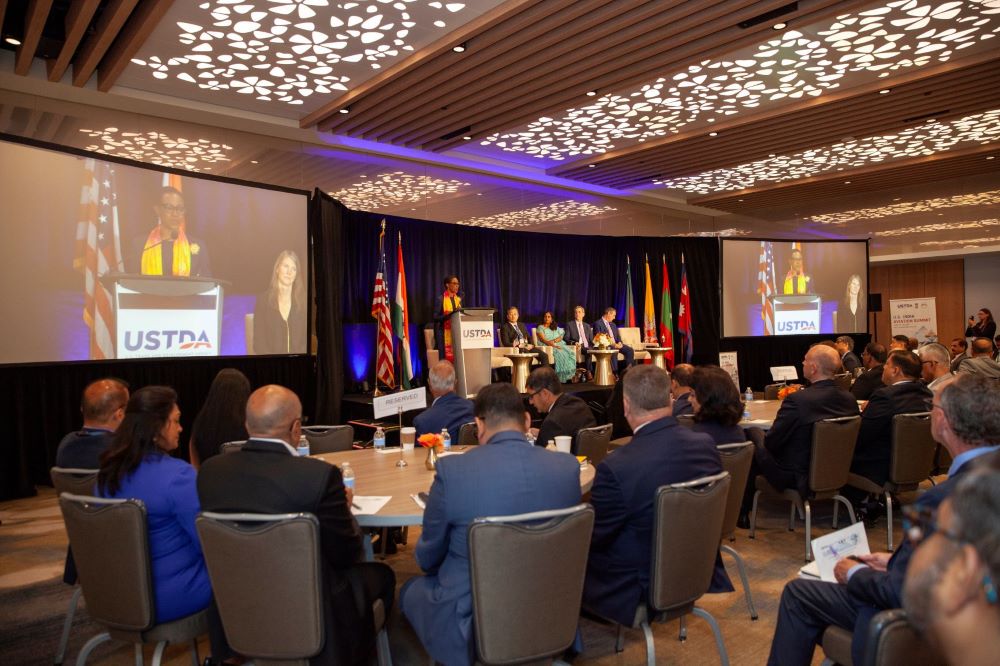“Indian Diaspora greatly benefits US-India Aviation relationship,” USTDA director
The summit highlighted various levels of partnerships in which the two countries are engaged in to set the course of the aviation industry.
 USTDA Director Enoh T. Ebong addressing the 7th US-India Aviation Summit. / X/@USTDA_Director
USTDA Director Enoh T. Ebong addressing the 7th US-India Aviation Summit. / X/@USTDA_Director
The Indian diaspora in the United States greatly benefits the aviation sector of the country, United States Trade and Development Agency Director Enoh T. Ebong said.
In her opening remarks at the 7th US-India Aviation Summit, a pivotal event bringing together roughly 250 government and industry leaders from the United States and India, Ebong highlighted how the two nations are cooperating in the aviation industry, a sector that significantly impacts global economy.
"This relationship benefits immensely from an Indian diaspora community in the United States that has created cultural educational and business ties between our countries that will endure for generations," Ebong said.
Speaking on the significance of the US-India Aviation Cooperation Program (ACP), Ebong highlighted that since its inception in 2007 the USTDA has supported multiple projects in India including the latest establishment of an integrated aviation hub in Hisar, Harayana, India.
“And yet, even with about 40 activities to show for our efforts under the ACP umbrella, we have only begun to scratch the surface of what this partnership could become,” she further added.
Concluding her speech, Ebong urged participants to think ambitiously and plan strategically. "This summit is an opportunity to set a course for the next chapter of our mutually beneficial aviation partnerships. Let us think without limitation and plan with intent," she stated, expressing optimism for the future of US-India aviation cooperation.
Vumlunmang Vualnam, Indian Secretary of the Ministry of Civil Aviation, underscored the resilient recovery of India's aviation sector post-COVID at the 7th US-India Aviation Summit. "Our air passengers have reached levels both in domestic and international flights akin to pre-COVID times," Vualnam noted.
He further highlighted India's commitment to sustainable aviation, detailing ambitious targets for blending Sustainable Aviation Fuel (SAF) with aviation turbine fuel: 1 percent by 2027, 2 percent by 2028, and 5 percent by 2030. "This initiative, developed collaboratively with the Ministry of Petroleum and Natural Gas, reflects India's dedication to climate change goals," he said.
The success of the Regional Connectivity Scheme (RCS) UDAAN was another key point in Vualnam's speech. He revealed that 569 new routes have been established, connecting 85 airports and extending to water aerodromes and heliports. "This regional connectivity scheme has had about 269,000 flights and carried about 13.9 million passengers," he remarked.
In a significant move to improve emergency medical services, Vualnam announced Project Sanjeevani, which will deploy HEMS helicopters in Uttarakhand to enhance medical access in hilly regions.
The secretary also shared that 20 percent of commercial pilot licenses issued in India last year were to women, with women constituting 30 percent of aviators in the country. "This achievement places India at the forefront globally in terms of female participation in aviation," he stated.
David Pekoske, Administrator of the US Transportation Security Administration (TSA), emphasized the importance of international partnerships in enhancing aviation security and efficiency. In that direction, he proposed placing a TSA representative (TSAR attaché) in the US embassy in Delhi to enhance local interaction and crisis management.
“I find that local interaction is so critically important in developing our partnership which anyway has a very strong foundation. As subject matter experts these TSAR’s can advise on security investments and procedures, help with crisis situations and resolve highly complete and potentially controversial transportation security issues,” he stated.
Michael Whitaker, Administrator of the US Federal Aviation Administration (FAA), shared his deep connection with India and the rapid growth of its aviation sector. Reflecting on his experiences launching United Airlines' Chicago-Delhi-Hong Kong service in the 1990s, Whitaker noted, "Domestic air traffic in India has surged from 143 million to 375 million."
Whitaker described the current period as a "renaissance of aviation," driven by strong recovery, where more people have access to air travel. In such a scenario, he said, “We need to work together in issues like safety. We need to share ideas and innovation especially on how to safely incorporate some of the new technologies in our airspace.”


 Malvika Choudhary
Malvika Choudhary


.jpg)
.jpg)
.png)
.png)

.png)

.png)
.jpg)

Comments
Start the conversation
Become a member of New India Abroad to start commenting.
Sign Up Now
Already have an account? Login